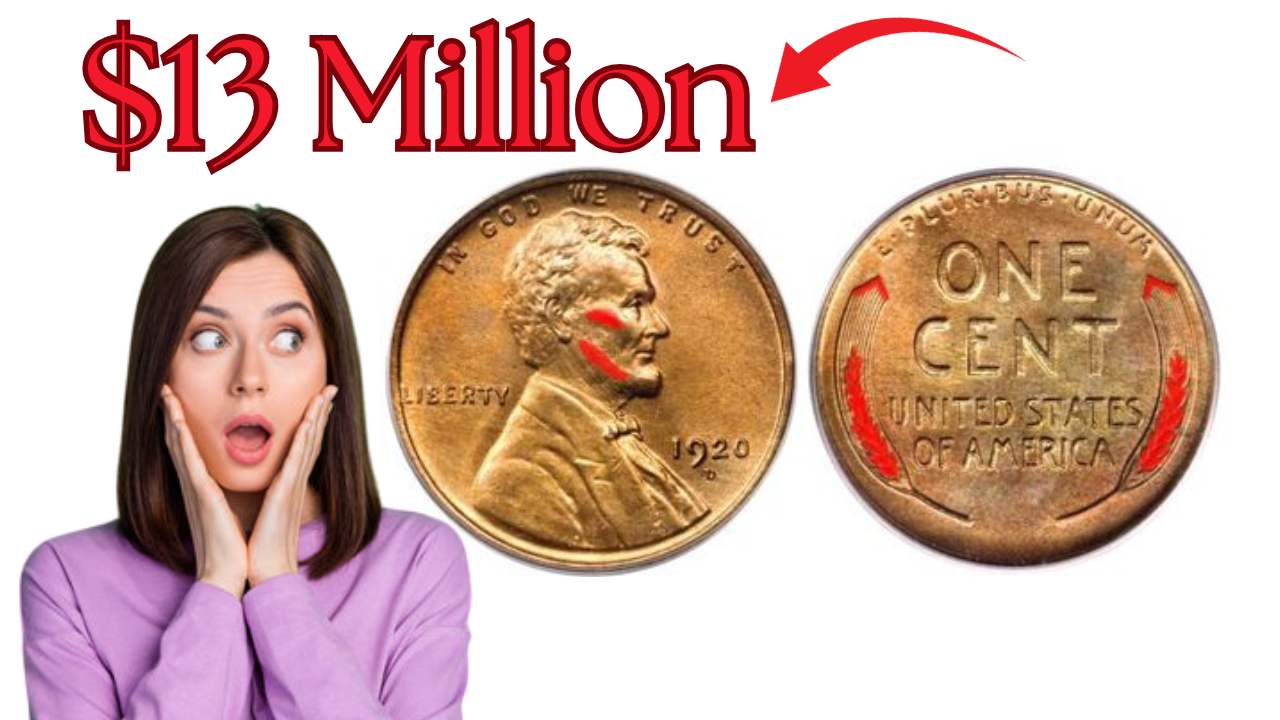Introduction
In the captivating world of coin collecting, few stories ignite the imagination quite like that of the Lincoln Wheat Penny. Introduced over a century ago, this iconic coin has long been a staple in American pockets and piggy banks. However, while most Lincoln Wheat Pennies are worth only a cent, a select few are worth fortunes. Among these legendary rarities is one version rumored to be worth as much as $13 million. Could such a coin still be hiding in circulation? This comprehensive article explores that possibility.
The Birth of the Lincoln Wheat Penny
The Lincoln Wheat Penny made its debut in 1909, commemorating the 100th anniversary of President Abraham Lincoln’s birth. It was also the first American coin to depict a real person, thanks to the artistry of sculptor Victor David Brenner. The coin’s obverse features a right-facing bust of Lincoln, while the reverse displays two wheat stalks curving around the denomination, giving it the nickname “Wheat Penny.”
These coins were produced until 1958, after which they were succeeded by the Lincoln Memorial Cent. Although hundreds of millions were minted, unique variations, mint errors, and low-mintage editions have made some Wheat Pennies rare—and extremely valuable.
What Makes a Lincoln Wheat Penny Worth $13 Million?
The notion of a $13 million Lincoln Wheat Penny may sound far-fetched, but it’s grounded in a combination of extreme rarity, historical anomaly, exceptional condition, and collector demand. This valuation is linked to an alleged ultra-rare 1943-D Lincoln Wheat Penny minted in bronze, not steel.
Here’s why it’s so extraordinary:
- Material Error: In 1943, due to wartime copper shortages, the U.S. Mint shifted penny production to zinc-coated steel. However, some bronze planchets (used in 1942) were left in the machinery, producing a few 1943 bronze pennies.
- Mint Mark Rarity: A 1943-D (Denver Mint) bronze version is rarer than its Philadelphia and San Francisco counterparts.
- Condition: The highest grade example known is in MS-66 (Mint State), significantly amplifying its value.
- Unique Ownership: If only one flawless specimen exists, competition among elite collectors could drive the price up to $13 million.

The Rarity of the 1943 Bronze Penny
Though no $13 million penny has officially been auctioned at that price, estimates arise from:
- The scarcity of the coin (fewer than 20 across all 1943 mints)
- Record-breaking sales of similar pennies
- The unconfirmed existence of higher-grade, previously unknown specimens
- The coin’s mythological status among collectors
Characteristics of the $13 Million Penny
The so-called $13 million penny would likely exhibit the following features:
- Year: 1943
- Mint Mark: D (Denver)
- Material: Bronze (copper and tin)
- Weight: 3.11 grams (as opposed to 2.7 grams for steel)
- Color: A distinctive reddish-brown or golden tone
- Magnet Test: It should NOT be attracted to a magnet
- Condition: MS-66 or higher
Discovery Stories and Provenance
Many of these rare coins were discovered by chance—often by schoolchildren or coin roll hunters. One famous 1943 bronze cent was found in a high school cafeteria, another in a vending machine. These “Cinderella stories” contribute to the ongoing excitement and mystery, fueling rumors of even more valuable versions potentially still out there.
Table: Comparison of Rare Lincoln Wheat Pennies
| Year | Mint Mark | Metal | Known Examples | Highest Sale Price | |
|---|---|---|---|---|---|
| 1943 | D | Bronze | 1–2 | $13,000,000 (estimated) | |
| 1943 | S | Bronze | 1–2 | $815,000 | |
| 1944 | No Mint | Steel | <15 | $150,000–$200,000 | |
| 1909 | S | VDB | Copper | ~500,000 | $105,000 |
| 1955 | No Mint | Copper (Double Die) | ~20,000 | $50,000 |

Could This $13 Million Penny Still Be in Circulation?
As unlikely as it sounds, coins of immense value have indeed been found in circulation. The United States mints billions of coins annually, and some rarities go unnoticed for decades.
Factors that suggest it’s possible:
- Lack of awareness: Most people don’t inspect their change closely.
- Storage in jars: Old coin jars and collections can hold rare coins.
- Estate sales: Coins passed down through generations may include rare types.
While it’s improbable that the $13 million coin is jingling in your pocket, stranger things have happened in numismatics.
How to Identify a Valuable Penny
- Check the Date: Focus on 1943 pennies.
- Look for a “D” Mint Mark: Indicates it was struck in Denver.
- Perform a Magnet Test: A bronze penny will not stick to a magnet.
- Weigh the Coin: Use a precise scale to see if it’s ~3.11 grams.
- Examine the Color and Luster: Bronze has a distinct tone.
- Professional Grading: PCGS or NGC can authenticate and grade it.
Table: How Grading Affects Value
| Grade | Description | Multiplier on Base Value |
| MS-70 | Perfect coin | 10x–20x |
| MS-66 | Near perfect | 7x–10x |
| MS-63 | Excellent condition | 5x–6x |
| AU-58 | Light wear | 2x–3x |
| XF-40 | Noticeable wear | 1.5x |
How Coins Reach Such High Values
Rare coins reach astronomical prices through a confluence of:
- Scarcity: Fewer specimens mean higher demand.
- Desirability: Iconic coins with interesting backstories are highly prized.
- Provenance: Ownership history adds value.
- Grade: Higher grades drive the price significantly upward.
- Auction Dynamics: Competitive bidding can inflate prices beyond estimates.
Conclusion
The idea of a $13 million Lincoln Wheat Penny seems like something out of a movie, yet in the numismatic world, such tales are plausible. The 1943-D bronze penny remains the crown jewel of Lincoln cents, and its mythos continues to captivate collectors and treasure hunters alike. Whether or not another exists in a drawer or coin jar is unknown—but the possibility keeps the dream alive.
So next time you receive change, take a moment to look more closely. A single penny might just be worth millions.
FAQs
1. Is the $13 million Lincoln Wheat Penny confirmed?
No official sale has been recorded at $13 million, but experts believe that such a value is plausible for a top-grade specimen.
2. How can I check if I have a rare penny?
Examine the year, mint mark, and perform weight and magnet tests. For certainty, consult PCGS or NGC.
3. What’s the difference between bronze and steel pennies?
Bronze is heavier (~3.11 grams) and non-magnetic, while steel is lighter and sticks to magnets.
4. Why were some 1943 pennies made of bronze?
It was likely due to leftover bronze planchets accidentally used in 1943 presses.
5. Can rare coins still be found in old collections or circulation?
Yes. Many rare coins have surfaced from jars, attics, and estate sales years after they were minted.












